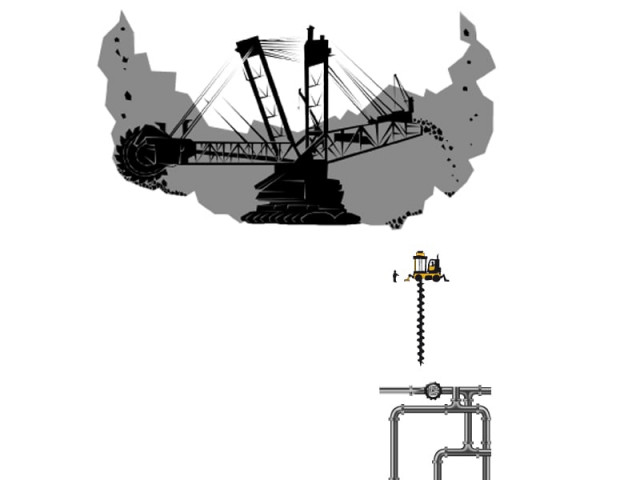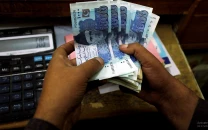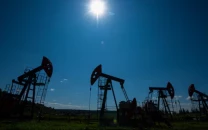Chasing a pipe dream: Three reasons why Thar coal will not save Pakistan
Pakistan’s coal reserves are in effect only the 134th largest coal reserves in the world.

To borrow and contort a famous turn of phrase from Matt Taibi’s now legendary piece of investigative journalism about Goldman Sachs, “the first thing you need to know about [global energy conglomerates] is that [they are] everywhere. The world’s most powerful [industry] is a great vampire squid wrapped around the face of [earth], relentlessly jamming its blood funnel into anything that smells like [fossil fuels].”
That is the image you need to wrap your minds around if you want to understand why Thar coal is not the lamp that will summon the jinn, to fix all of Pakistan’s energy and economic problems if only rubbed the right way by that right clean, patriotic leadership of lore. You need to envision this monster squid sticking its tentacles down every hole that smells even remotely of juice and then you need to ask yourself, doesn’t the brandished juiciness of Thar’s coal reserves sound succulent enough for that behemoth to have stuck its arms deep into it by now. After all, it’s already here, not even miles away from Thar in gas fields from Bhit to Qadirpur, quietly sucking up fossil fuels from innumerous holes. If BP, Eni, MOL and others can find a way to drill, build and operate in Sindh, why haven’t Peabody Energy got a whiff of all that solid black gold buried underground yet and come looking for it. The answer to that question, unfortunately for Pakistan, is that, unlike the gas and the oil, and the copper to the west in Balochistan, the coal simply isn’t worth it. It isn’t worth the trouble, worth the bureaucratic hassles, worth braving the security risks, worth going half-way around the world for. It isn’t worth it in terms of bare dollar amounts, in terms of ecological economics or in terms of energy return on energy input. Now, don’t make a mistake here. There’s significant amount of energy to be had from Thar’s coal reserves, but in the national context. Not in the global context. If someone tells you Thar’s coal reserves are the largest, or the second largest, or even in the top ten in the world, ask them for their sources. They are wrong.
Why the numbers don’t add up
According to the World Energy Council, Pakistan has a little more than 2,000 million tons of proven recoverable coal reserves. That number is supported by British Petroleum’s similar estimates and contrasts with the Sindh Government’s total predicted estimates of about 2,357 million tons (this number does not include ‘indicated’ and ‘inferred’ reserves). This compared with Germany’s lignite reserves of about 40,600 million tons and India’s reserves of about 4,500 million tons seems small. Pakistan’s coal reserves are in effect only the 134th largest coal reserves in the world. But if you want to know what a resource is really worth, you need to rely on the word of someone who’s willing to pay for it. The last company that was willing to invest in Thar’s coal reserves, the Shenhua Group China, estimated that they could produce about 3.5 million tons of coal per year from the mines, which they translated into 600 MW of power generation. Pakistan’s energy shortage is now in the thousands of megawatt per day.
It is important to measure the potential of Thar coal in terms of megawatts of power per day because the kind of coal that Thar has, is of little use besides conversion to electricity onsite. Lignite, which is the least energy intensive form of coal, according to some definitions, is not coal at all. In fact, it is considered a dirty energy source lying somewhere on the spectrum between coal and peat with carbon content between 25% to 35%. The fixed carbon content of Thar coal is less than 22%. The low carbon content translates into low energy generation capacity, which means that if energy is invested into transporting the lignite from source to point of consumption, the net energy output of the mining, extraction, transportation and conversion process becomes less than zero; you end up investing more energy making energy out of coal than you get out of it in terms of megawatts. In order to get any energy out of lignite, it has to be converted into electricity almost entirely onsite; where it is being mined. Which brings us to the first reason why Thar coal will not save Pakistan.
There isn’t enough water
The methodology of getting lignite out of ground is called strip mining. You basically dig a big hole in the ground and the more coal you get out, the bigger the hole gets. Strip mining requires extensive amounts of water depending on the methodology used with estimates varying from 10 to 150 gallons of water for one ton of coal mined. Assuming minimum water requirement, mining 3.5 million tons of coal per year would require 35 million gallons of water per year or roughly about 100,000 gallons of water per day. Power production has further extensive water requirements. Sindh government is assuring investors an eventual water supply of about 300,000 gallons of water per day. Where is this water going to come from? Pakistan is a “water stressed” country on the verge of “water scarcity”, with the people of Thar being the most deprived in a nation of water deprived people. Yes, we are an energy starved nation, but more so than that we are a thirsty nation, who’ve let one of the richest water resource regimes in the world go to waste through lack of development and irresponsible usage. Make no mistake about it, the energy gained through Thar coal will come at a cost of water loss to the people who can least afford it. What complicates the matter even more is the fact that mining for coal in an area where the primary source of drinking water is subsurface aquifer, can end up contaminating the water supply of a very vulnerable population. Especially when, as in Thar, there are connected aquifers, above, within and below the coal zone.
Magic bullets don’t work
The impracticality of the water situation has lead some in Pakistan’s scientific elite to consider unproven technologies. Underground Coal Gasification (UCG) is one such technology.
Unfortunately though, the risk of aquifer contamination is highest in UCG of all the techniques of extracting energy from underground coal. UCG is an experimental methodology where coal is not mined but sparked underground and the gas generated through this combustion is collected through wells. While this methodology does not have the high surface footprint and risks of strip mining, it offers extensive water contamination opportunities as the gas generated through combustion underground is hard to control. It can never be guaranteed to not mix with the subsurface water . But that’s the least of the problems with UCG. The experimental nature of UCG means that there are very few places in the world where this technology has been successfully implemented. No commercial UCG production wells exist and there are very few experts; individuals or companies who are competent enough to execute UCG projects flawlessly. UCG projects are economically feasible only if the coal reserves cannot be reached through traditional means and that is not the case here. Also, UCG is only recommended in coal beds which are isolated from aquifers. That is not the case in Thar either. So let’s recap; UCG is an experimental methodology that people at the helm of the UCG project in Thar have no expertise or experience in, there is no need to implement UCG in Thar and the technology if implemented will most certainly contaminate the only water source of a very vulnerable population.
The reason some of the claims of the UCG project leadership about potential of the project sound too good to be true, is because they are. The key to remember here is this; magic bullets don’t work. And miracle cures, more often than not, turn out to be nothing more than snake oil.
Thar coal is not a sustainable energy source
There is a litany of environmental problems associated with coal mining and electricity generation, with coal being the “dirtiest” of all fossil fuel sources, but environmental problems are not the real reason why Thar coal will not save Pakistan.
Thar coal cannot solve our energy problems, balance our budget, put food on every deprived Sindhi household’s table or lift Pakistan out of poverty, because coal is a fossil fuel and a finite resource. To understand the significance of this statement, think about this. When Sui gas was discovered in 1952 it was estimated that this energy source will last us for at least a hundred years. We were all set for three generations. For a hundred years we knew our stoves will stay warm, literally. Then, growth happened. Lots of it. Suddenly, unbelievable as it may have seemed once, we’d run out of gas. Gas was gone.
In terms of net energy, Thar’s reserves are a fraction of the embarrassment of riches that was found in Sui six decades ago. At current growth rates, they will last us no longer than twenty five years. What then?
This is not to say that we shouldn’t exploit Thar’s energy potential. By all means, we need to tap that resource as soon as possible — giving due consideration to environmental concerns of course — and exploit as much of it as we can without hindering on the water rights of the locals. But we must not forget that despite being a potential medium term respite, Thar coal is no solution to Pakistan’s long term energy problems. Pakistan has extensive wind and hydel renewable potential. Small dams along the stretch of Indus and the sprouting of wind farms along our beautiful jagged coast are the only truly sustainable options that can secure Pakistan’s energy future.
The writer is an energy, environment and water resources consultant based in Hungary.
Published in The Express Tribune, January 23rd, 2012.

1728020501-0/Express-Tribune-Web-(13)1728020501-0-208x130.webp)

















COMMENTS
Comments are moderated and generally will be posted if they are on-topic and not abusive.
For more information, please see our Comments FAQ